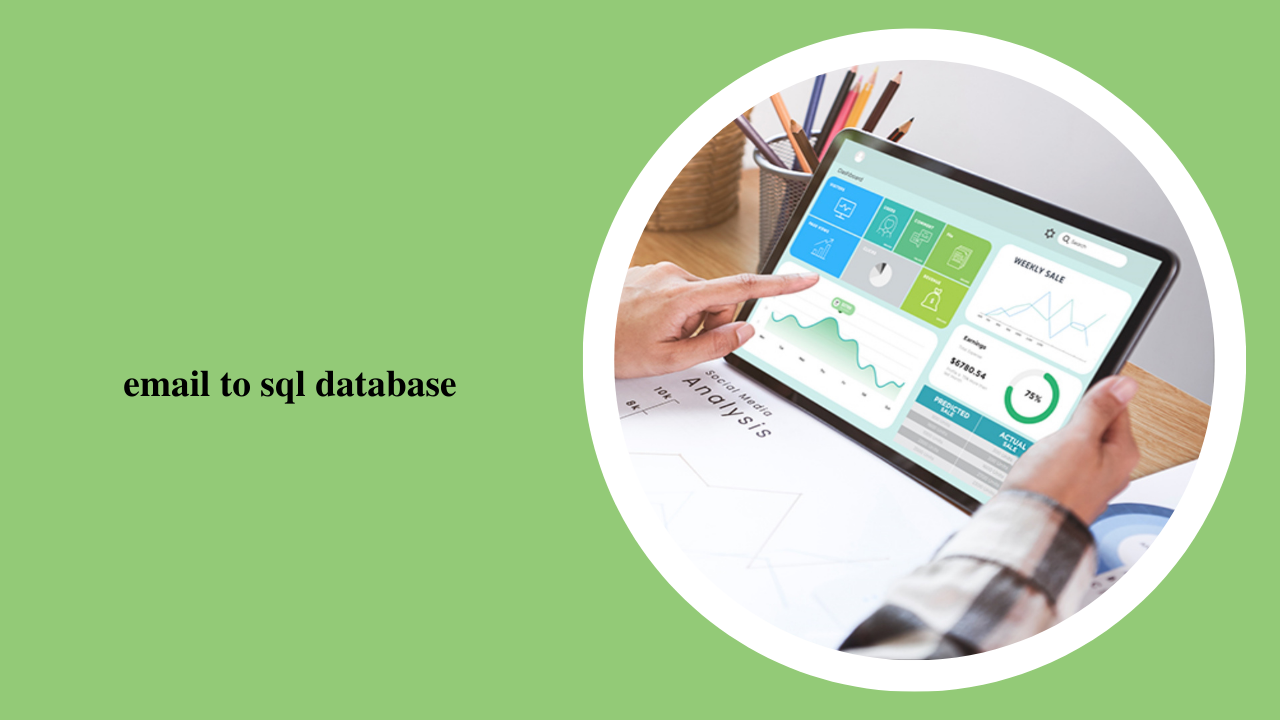Super Cool Way to Save Email Stuff in a Computer Box
Have you ever gotten an email with important information? Maybe it was an order for something you sell. Or perhaps it was a form filled out by someone. Instead of just keeping that information in your email, wouldn't it be great if you could put it in a special computer box where you can easily find it later? This special box is like a super organized filing cabinet called a SQL database. Saving email information to a SQL database can be really helpful. It's like taking the important parts out of your emails and putting them neatly into labeled folders in your filing cabinet. This way, you can easily look up that information whenever you need it. So, let's learn how we can make emails talk to this computer box!
After understanding what it means to save email information to a SQL database, you might be wondering why anyone would want to do that. Well, there are actually many good reasons!
Why Put Your Emails into a Computer Box?
Imagine you get many emails every day. Some might have customer names, addresses, and what they want to buy. If you keep all of this just in your email, it can become very messy and hard to find what you're looking for. However, if you put this information into a SQL database, it's like having all that important stuff neatly organized in tables. You can easily search for a specific customer's order or see how many people ordered a certain item. Moreover, it helps you keep track of things better. For example, if you run a small online shop, you can easily see all your orders in one place. This makes it much easier to manage your business. Also, you can use this information to create reports and understand your business better. For instance, you can see which products are most popular.
Furthermore, a SQL database is very good at storing and managing large amounts of information. As your business or your email flow grows, your database can handle more and more data without slowing down. On the other hand, having thousands of emails in your inbox can make your email program slow. So, using a database helps keep things efficient. In addition, you can connect your database to other tools and software. For example, you could connect it to a program that creates invoices automatically. This can save you a lot of time and effort. Therefore, saving email information to a SQL database makes things more organized, efficient, and helps you work smarter.
Now that we know why it's a good idea, let's explore some ways to actually get the information from your emails into that SQL computer box.
Different Ways to Get Email Stuff into the Box
There isn't just one way to move information from your emails to a SQL database. Just like there are different ways to travel, there are different methods for this too! Let's look at a few of them.
Using Special Programs That Do It Automatically
One way is to use special computer programs or services that are designed to take information from your emails and put it directly into a SQL database. These programs often work by connecting to your email account and looking for certain types of emails. For example, if you receive an email with a specific subject line, like "New Order," the program can automatically extract the customer's name, address, and the items they ordered. Then, it puts this information into the correct places in your SQL database. This is like having a robot assistant who reads your emails and files the important details for you. Consequently, this method can save you a lot of time and effort, especially if you receive many emails with important data. Moreover, these programs can often be customized to look for specific information in your emails and put it exactly where you need it in your database.
Doing It Yourself Manually
Another way is to do it yourself. This means that when you receive an email with important information, you would manually copy the relevant parts and then paste them into your SQL database. For instance, if you get an email with a customer's feedback, you could copy their comments and then add them to a table in your database that stores customer feedback. This method takes more time and effort because you have to do it for every email. However, it might be jamaica whatsapp lead a good option if you only receive a few emails with important information each day. Also, doing it yourself gives you more control over exactly what information gets saved and where it goes in the database. Furthermore, it can be a good way to understand the process better, especially when you are just starting out.
Using Tools That Help You Connect Emails and Databases
There are also some tools that act like bridges between your email and your SQL database. These tools might provide a way for you to set up rules. For example, you could tell the tool that whenever you receive an email with an attachment in a certain format (like a spreadsheet), it should automatically take the data from that attachment and put it into a specific table in your SQL database. This is like having a smart helper that follows your instructions on how to handle certain types of emails. Therefore, this can be a good middle ground between doing everything automatically and doing everything manually. Besides, these tools often offer more flexibility and customization options compared to fully automatic programs.
After considering these different methods, it's important to think about a few things before you start sending your email data to a SQL database.

Things to Think About Before You Start
Just like you need to plan before you start a big project, there are some important things to consider before you start saving information from your emails into a SQL database.
What Information Do You Need to Save?
First, you need to decide exactly what information from your emails is important enough to save in the database. Do you need the sender's email address? The subject line? The date and time the email was received? The content of the email? Or perhaps just certain pieces of information within the email, like a name or a product code? Identifying the specific data you need will help you set up the process correctly, whether you are using an automatic program, doing it manually, or using a connecting tool. For example, if you are tracking customer orders, you would likely need the customer's name, the products they ordered, and their shipping address. Consequently, focusing on only the necessary information will keep your database clean and efficient.
How Will the Information Be Organized in the Database?
Next, you need to think about how you want to organize the information in your SQL database. Databases use tables to store data, similar to spreadsheets. You need to decide what tables you will need and what columns (like headings in a spreadsheet) each table will have. For instance, if you are saving customer orders, you might have a table called "Orders" with columns for "CustomerID," "OrderDate," "ProductName," and "Quantity." Planning this structure beforehand is crucial for making sure your data is easy to find and use later. Moreover, a well-organized database will make it easier to search for specific information and create reports. Therefore, take some time to design your database structure before you start importing data.
After understanding what it means to save email information to a SQL database, you might be wondering why anyone would want to do that. Well, there are actually many good reasons!
Why Put Your Emails into a Computer Box?
Imagine you get many emails every day. Some might have customer names, addresses, and what they want to buy. If you keep all of this just in your email, it can become very messy and hard to find what you're looking for. However, if you put this information into a SQL database, it's like having all that important stuff neatly organized in tables. You can easily search for a specific customer's order or see how many people ordered a certain item. Moreover, it helps you keep track of things better. For example, if you run a small online shop, you can easily see all your orders in one place. This makes it much easier to manage your business. Also, you can use this information to create reports and understand your business better. For instance, you can see which products are most popular.
Furthermore, a SQL database is very good at storing and managing large amounts of information. As your business or your email flow grows, your database can handle more and more data without slowing down. On the other hand, having thousands of emails in your inbox can make your email program slow. So, using a database helps keep things efficient. In addition, you can connect your database to other tools and software. For example, you could connect it to a program that creates invoices automatically. This can save you a lot of time and effort. Therefore, saving email information to a SQL database makes things more organized, efficient, and helps you work smarter.
Now that we know why it's a good idea, let's explore some ways to actually get the information from your emails into that SQL computer box.
Different Ways to Get Email Stuff into the Box
There isn't just one way to move information from your emails to a SQL database. Just like there are different ways to travel, there are different methods for this too! Let's look at a few of them.
Using Special Programs That Do It Automatically
One way is to use special computer programs or services that are designed to take information from your emails and put it directly into a SQL database. These programs often work by connecting to your email account and looking for certain types of emails. For example, if you receive an email with a specific subject line, like "New Order," the program can automatically extract the customer's name, address, and the items they ordered. Then, it puts this information into the correct places in your SQL database. This is like having a robot assistant who reads your emails and files the important details for you. Consequently, this method can save you a lot of time and effort, especially if you receive many emails with important data. Moreover, these programs can often be customized to look for specific information in your emails and put it exactly where you need it in your database.
Doing It Yourself Manually
Another way is to do it yourself. This means that when you receive an email with important information, you would manually copy the relevant parts and then paste them into your SQL database. For instance, if you get an email with a customer's feedback, you could copy their comments and then add them to a table in your database that stores customer feedback. This method takes more time and effort because you have to do it for every email. However, it might be jamaica whatsapp lead a good option if you only receive a few emails with important information each day. Also, doing it yourself gives you more control over exactly what information gets saved and where it goes in the database. Furthermore, it can be a good way to understand the process better, especially when you are just starting out.
Using Tools That Help You Connect Emails and Databases
There are also some tools that act like bridges between your email and your SQL database. These tools might provide a way for you to set up rules. For example, you could tell the tool that whenever you receive an email with an attachment in a certain format (like a spreadsheet), it should automatically take the data from that attachment and put it into a specific table in your SQL database. This is like having a smart helper that follows your instructions on how to handle certain types of emails. Therefore, this can be a good middle ground between doing everything automatically and doing everything manually. Besides, these tools often offer more flexibility and customization options compared to fully automatic programs.
After considering these different methods, it's important to think about a few things before you start sending your email data to a SQL database.

Things to Think About Before You Start
Just like you need to plan before you start a big project, there are some important things to consider before you start saving information from your emails into a SQL database.
What Information Do You Need to Save?
First, you need to decide exactly what information from your emails is important enough to save in the database. Do you need the sender's email address? The subject line? The date and time the email was received? The content of the email? Or perhaps just certain pieces of information within the email, like a name or a product code? Identifying the specific data you need will help you set up the process correctly, whether you are using an automatic program, doing it manually, or using a connecting tool. For example, if you are tracking customer orders, you would likely need the customer's name, the products they ordered, and their shipping address. Consequently, focusing on only the necessary information will keep your database clean and efficient.
How Will the Information Be Organized in the Database?
Next, you need to think about how you want to organize the information in your SQL database. Databases use tables to store data, similar to spreadsheets. You need to decide what tables you will need and what columns (like headings in a spreadsheet) each table will have. For instance, if you are saving customer orders, you might have a table called "Orders" with columns for "CustomerID," "OrderDate," "ProductName," and "Quantity." Planning this structure beforehand is crucial for making sure your data is easy to find and use later. Moreover, a well-organized database will make it easier to search for specific information and create reports. Therefore, take some time to design your database structure before you start importing data.


